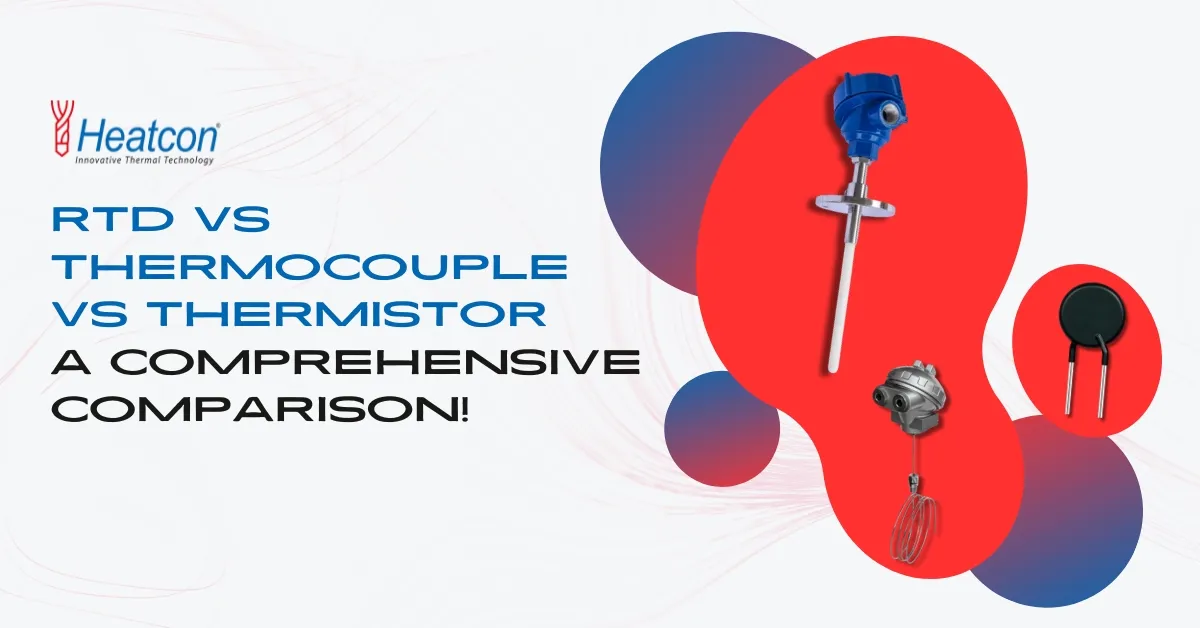Understanding Temperature Sensors: RTDs, Thermocouples & Thermistors
Temperature happens to be an important parameter in a gamut of industry-run processes, including electronics, & several scientific applications as well. Selecting the apt temperature sensor can considerably affect precision of measurement, efficiency of the processes, quality of the products produced & safety as well. The 3 most commonly used temperature sensors happen to be the RTDs (resistance temperature detectors), Thermocouples, & Thermistors. From a report given by MarketsandMarkets, we can decipher that the global temperature sensor market has been projected to reach 8.22 billion dollars by the year 2026, and it is growing at a CAGR of 6.8 percent from the year 2021. This emphasizes the growing need for precise temperature measuring devices across a gamut of industries. Let us take a detailed look at RTD vs Thermocouple vs Thermistor, understanding their mechanisms, pros & cons, and their practical applications too. Let us have a clear understanding of the difference between thermocouple and thermistor, and also check the differences in thermocouples and RTDs, and in which industrial process which sensor is best suited.
RTDs
RTD happens to be a temperature sensor, which tends to operate on the principle that a material’s resistance actually alters with changing temperatures. Normally created out of pure platinum, nickel, or copper, these RTD sensors are known for their precision & dependability. Platinum RTDs, like the popular Pt100, tend to provide great repeatability. These are most commonly utilised in some of the industrial, scientific, & medical applications.
Key Features of RTDs
- Accuracy: RTDs tend to provide a greater degree of precision than other sensors, specifically over a broad range of temperature (-200 degrees Celsius to 850 degrees Celsius).
- Stability: RTDs tend to be very stable over time. This quality makes them suited for long-term monitoring in some of the most critical industrial applications.
- Linear Response: RTDs tend to have an almost linear relationship between resistance & temperature, which simplifies data interpretation.
Applications of RTDs
RTDs are usually made use of in those industrial processes where accurate & stable temperature readings are crucial. While RTDs excel in accuracy, these could be heavy on the pockets & fragile on their makes as compared to other sturdier temperature sensors. This makes them less suited for those industrial applications where robustness or cost-efficiency tends to be a priority. Their applications include the following:
- HVAC systems
- Food & beverage production
- Medical equipment (like in incubators)
- Industrial process control (like in chemical processing)
Thermocouples
Thermocouples tend to be quite versatile temperature sensors, which are made by joining 2 distinct metal alloys to form a junction. When such a junction is exposed to temperature deviations, a voltage tends to be produced, which you can correlate to temperature. Thermocouples are largely utilised owing to their durability, broad range of temperature, and cost-efficiency.
Key Features of Thermocouples
- Durability: Thermocouples have highly sturdy makes. They can withstand very harsh environments such as pressure, vibrations, as well as corrosive surroundings.
- Cost-Effective: Thermocouples are usually more light on the pocket in comparison to RTDs and Thermistors.
- Broad Temperature Range: Thermocouples can read extreme temperatures, ranging from -200 degrees Celsius to 2500 degrees Celsius, depending on the type (example Type K or Type J etc).
Applications of Thermocouples
Thermocouples tend to provide good response times and can operate in conditions that may destroy other types of temperature sensors. But they tend to be less accurate than RTDs, especially at lower temperatures. Thermocouples are used across a gamut of industries owing to their resilience & broad temperature measurement range:
- Aerospace industry
- Automotive industry
- Metal processing segment
- Petrochemical sector
- Power generation plants
- Household appliances (like ovens & water heaters)
Thermistors
Thermistors are those temperature sensors, which work based on the principle that a material’s resistance alters greatly with temperature. Unlike RTDs, thermistors are formed out of ceramic or polymer materials. Their resistance alters in a greatly nonlinear way with temperature changes.
Key Features of Thermistors
- Cost-Effective: These are usually more affordable than RTDs. They are commonly used in consumer-grade products.
- High Sensitivity: These are extremely sensitive to small changes in temperatures. This quality makes thermistors apt for those applications which need accurate measurements over a limited range.
- Limited Temperature Range: These are typically used in a temperature range of -50 degrees Celsius to 150 degrees Celsius, though some specialised ones can even go beyond this range.
Applications of Thermistors
While thermistors are highly sensitive, their non-linear response & limited temperature range make them less versatile than RTDs or thermocouples for several types of industry-related applications. These are best suited for applications where high sensitivity over a small temperature range is needed:
- Environment monitoring
- Medical devices (like in thermometers)
- Automotive temperature control systems
- Consumer electronics (example battery monitoring in smartphone)
RTD vs Thermocouple vs Thermistor: A Comprehensive Guide to Measuring Temperature Accurately
To fathom which temperature sensor is best for your application, it is highly crucial for you to consider the difference between thermistor and thermocouple, and the difference between thermocouple and RTD, and other factors. Below is a detailed comparison of RTD vs Thermocouple vs Thermistor across different key factors:
- Accuracy
- RTDs: They offer the highest accuracy, usually within ±0.1 degrees Celsius.
- Thermocouples: They are moderately accurate but less so than RTDs, with a typical range of ±1 degrees Celsius to ±2 degrees Celsius.
- Thermistors: These are very accurate over a small range but less consistent over a braod temperature range.
- Response Time:
- RTDs: They have a slower response time due to their mass & construction.
- Thermocouples: These respond faster to temperature changes, making them suitable for dynamic environments.
- Thermistors: They also respond quickly but within their limited range.
- Temperature Range:
- RTDs: They can measure temperatures between -200 degrees Celsius and 850 degrees Celsius.
- Thermocouples: These have the widest range, capable of measuring from -200 degrees Celsius to 2500 degrees Celsius as per the type.
- Thermistors: Thermistors are limited to a much smaller range of -50 degrees Celsius to 150 degrees Celsius.
- Durability:
- RTDs: These are less durable & more susceptible to damage in harsh conditions.
- Thermocouples: Thermocouples are the most durable, able to withstand extreme conditions like high pressure, vibrations, & corrosive environments.
- Thermistors: They are usually not suitable for industrial environments & may degrade over time.
- Cost:
- RTDs: These are usually the most expensive ones owing to their accuracy & materials involved.
- Thermocouples: They are relatively inexpensive, specifically when considering their wide temperature range & durability.
- Thermistors: Thermistors are the most cost-efficient for applications that do not need extreme temperature ranges and/or durability.
- Linearity:
- RTDs: RTDs offer the most linear relationship between temperature & resistance.
- Thermocouples: Thermocouples have a non-linear response, especially at extreme temperatures.
- Thermistors: Thermistors have a highly non-linear response that can complicate data interpretation.
RTDs, Thermocouples, & Thermistors Provided by Heatcon Sensors
At Heatcon Sensors, we tend to provide a broad range of temperature sensors, including RTD, thermocouple & thermistor for measuring temperature. These are designed for precision, dependability, & longevity across different applications. Each of our temperature sensors is engineered to meet the highest standards, ensuring reliable performance in your specific industrial applications.
- RTDs: Heatcon provides high-precision platinum RTDs like the Pt100 for industrial & scientific applications where accuracy is most important.
- Thermocouples: Our range includes Type K, J, and many other types of thermocouples, which are known for their broad temperature ranges & sturdiness even in the most challenging environments.
- Thermistors: We provide thermistors ideal for applications that need sensitive temperature measurements over smaller ranges, like in the HVAC systems & in consumer electronics.
Procure Temperature Sensors from Heatcon Sensors
Whether you need an RTD sensor, a Thermocouple, or a Thermistor, Heatcon Sensors is your go-to source for top-quality temperature sensors. Our extensive product range tends to cover most of the industrial needs today, from precise lab settings to rugged industrial environments. Contact us today to discuss your temperature measurement need and find the most ideal solution for your business. Heatcon Sensors is committed to providing reliable & durable products that meet your specifications, ensuring your operations run slickly & ably. With the knowledge of the thermocouple and RTD difference and difference between thermocouple and thermistor, and the various applications of each, you can now confidently select the apt sensor for your temperature measurement requirements.


